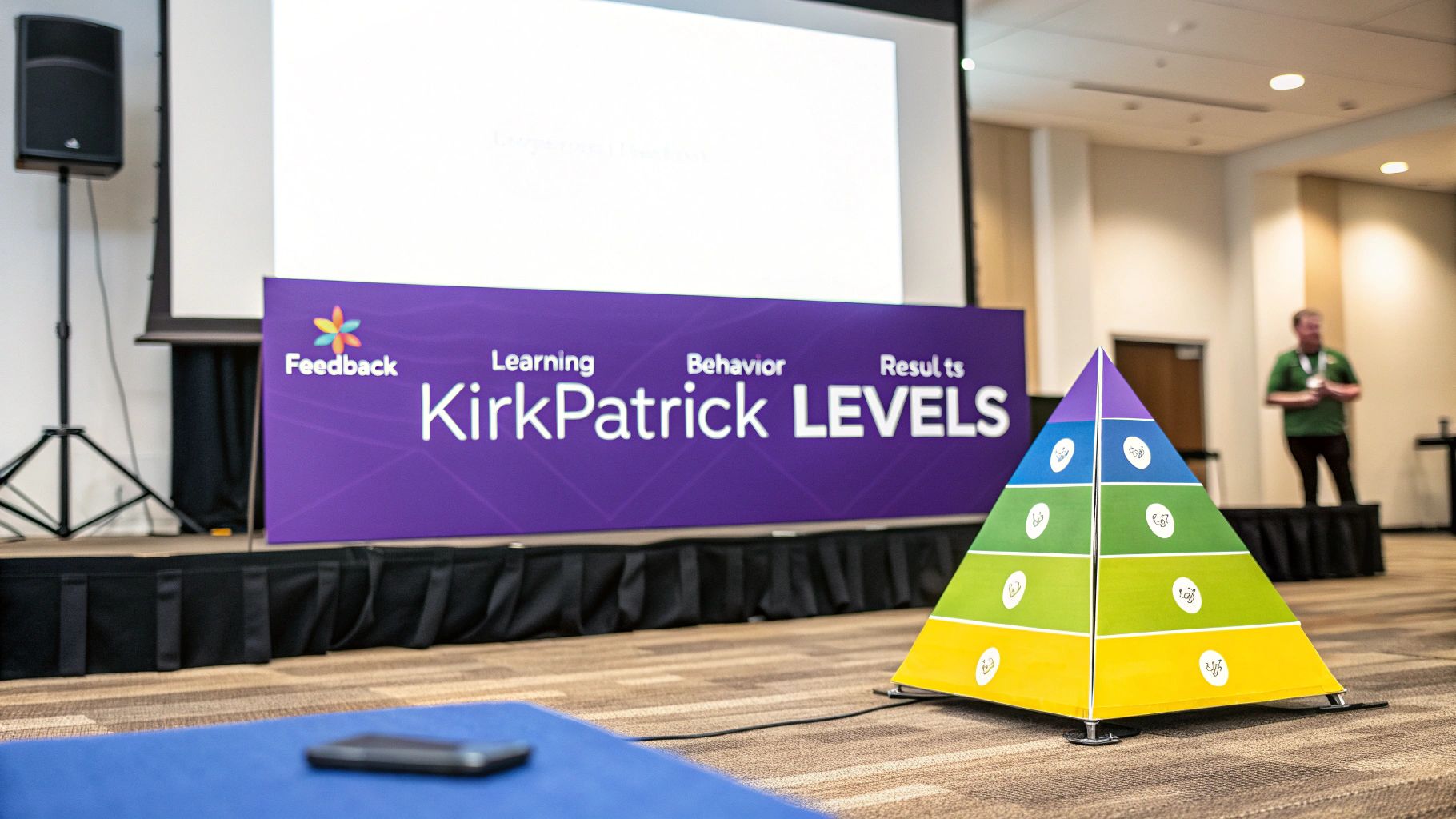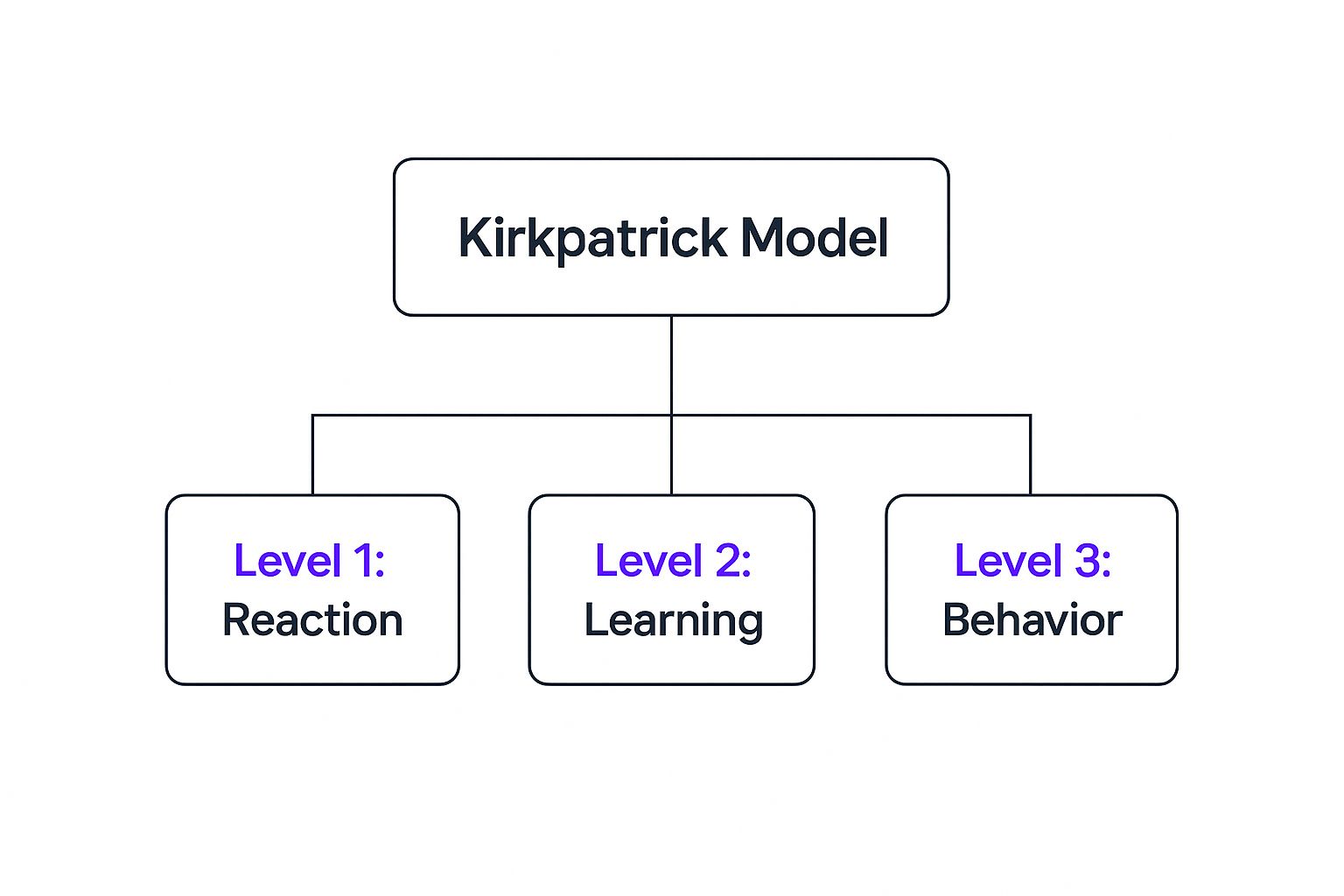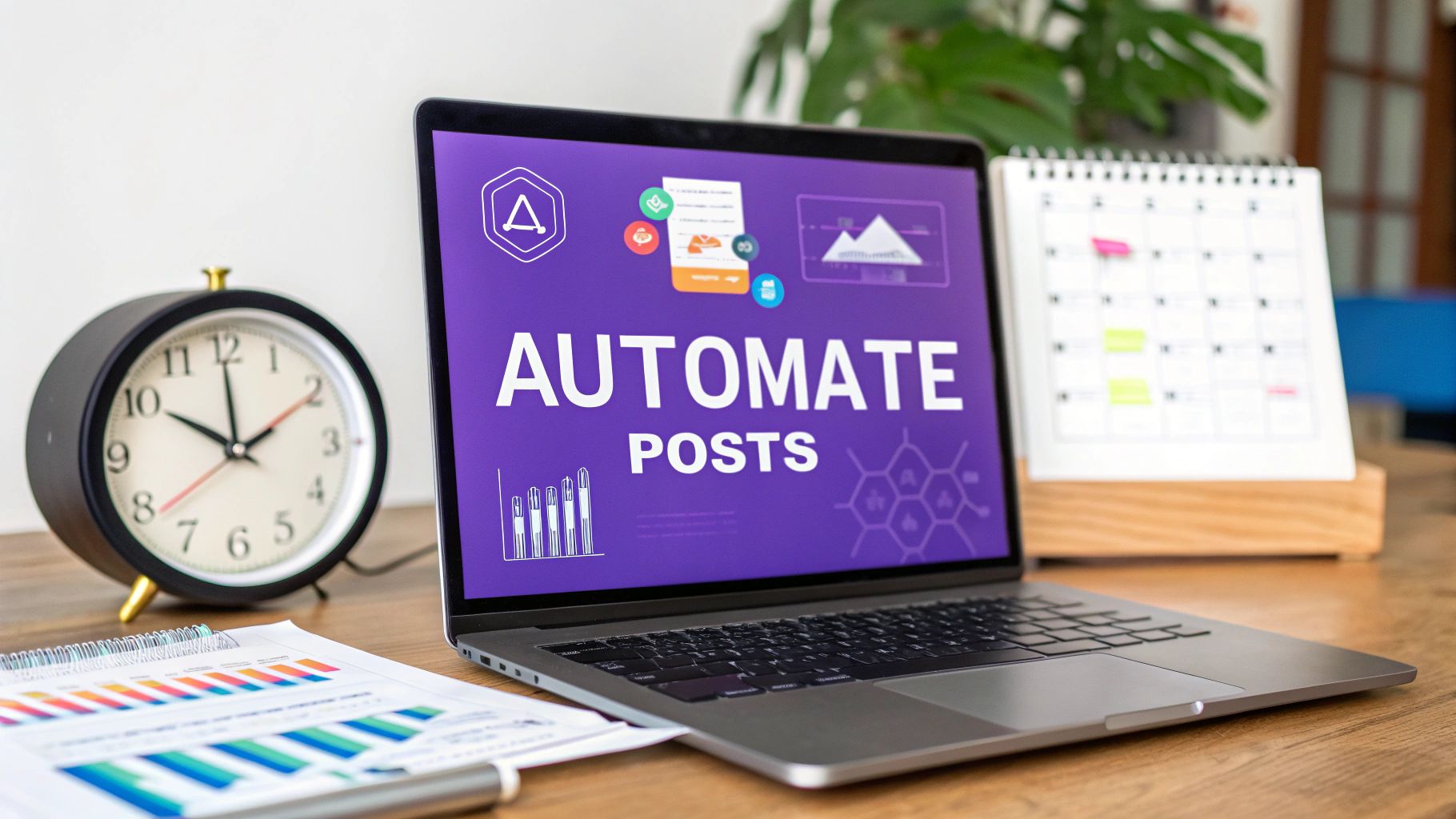Master Kirkpatrick Levels of Evaluation for Effective Training

The Kirkpatrick Levels of Evaluation offer a proven, four-part framework for measuring how effective your training really is. It’s designed to move you beyond simple “smile sheets” and uncover the real business impact of any learning program.
Understanding the Kirkpatrick Evaluation Model
Think about the last time your company rolled out a big training initiative. How did you really know if it worked? Did it just give employees a nice day away from their desks, or did it actually change how they do their jobs and contribute to the bottom line?
This is exactly the problem the Kirkpatrick model was designed to solve. It gives you a structured roadmap to connect learning programs to tangible, measurable business outcomes.
The Kirkpatrick Model is a cornerstone of the broader field of educational program evaluation. It works like a pyramid, with each level building on the one before it, giving you progressively deeper and more valuable insights.
The Four Foundational Levels
First introduced by Donald Kirkpatrick way back in 1959, the model is still the global gold standard for assessing training. It breaks the process down into four distinct stages: Reaction, Learning, Behavior, and Results. Each level answers a more critical question than the last, moving from a gut check on how the training was received to its ultimate impact on the organization.
Here’s a quick breakdown of the core ideas:
- Level 1: Reaction — This is all about gauging how participants felt about the training. Were they engaged? Did they find it relevant and worthwhile?
- Level 2: Learning — This measures what people actually learned. Did their knowledge, skills, or even their attitudes change because of the training?
- Level 3: Behavior — This looks at whether participants are applying their new knowledge back on the job. Have their day-to-day actions and behaviors actually changed?
- Level 4: Results — This is the bottom line. It evaluates the final impact on the business. Did the training move the needle on things like productivity, quality, sales, or profits?
This classic visualization shows how the Kirkpatrick Model is often seen as a progressive hierarchy.

As you can see, each level provides a more meaningful measure of training effectiveness, all leading up to the ultimate goal: business results. The climb up the pyramid gets a bit more complex at each stage, but the value of the insights you gain becomes far more significant.
To help you see how these levels work together, here’s a quick summary table.
The Four Kirkpatrick Levels at a Glance
This table breaks down each level, explaining what it measures and the common methods used for evaluation.
| Level | What It Measures | How It's Measured |
|---|---|---|
| Level 1: Reaction | Participants' immediate feelings and satisfaction with the training. | Surveys, feedback forms, informal comments, "smile sheets." |
| Level 2: Learning | The increase in knowledge, skills, and changes in attitude post-training. | Pre- and post-tests, quizzes, interviews, hands-on skill assessments. |
| Level 3: Behavior | The extent to which participants apply their learning on the job. | On-the-job observations, 360-degree feedback, performance reviews, manager reports. |
| Level 4: Results | The final impact of the training on business outcomes and the organization. | Key Performance Indicators (KPIs), ROI analysis, quality metrics, productivity data. |
Looking at the model this way makes it clear how each step is a building block for the next. You can't get to lasting behavior change (Level 3) without effective learning (Level 2), and you certainly can't achieve business results (Level 4) if behaviors don't change.
Level 1 Reaction: How Participants Felt About the Training

Level 1 is the first and most immediate layer of the Kirkpatrick levels of evaluation, and it’s all about participant reaction. Think of it like taking a quick temperature check right after a training session. Did they find it engaging? Was the material relevant to their job? Did they actually like it?
This level gets right to the heart of satisfaction and engagement. While a happy participant doesn't guarantee they've mastered new skills, their initial reaction is a crucial first signal.
After all, a negative experience is a huge red flag. If learners felt the session was a waste of time, it's almost certain that no real learning (Level 2) or on-the-job change (Level 3) will follow.
Gathering Quality Feedback
The classic way to capture Level 1 data is the post-training "smile sheet." But to get feedback that’s actually useful, you need to move beyond just asking if people enjoyed the free coffee. The goal is to ask smarter questions that provide real insight.
Instead of generic ratings, try asking questions like these:
- Did you feel the training environment helped you learn?
- How confident are you in applying what we covered today?
- What was the single most valuable part of this session for your day-to-day work?
- Was the pace of the training too fast, too slow, or just right?
By shifting the focus from "Did you like it?" to "How will you use it?", you start building a bridge from Level 1 Reaction to Level 3 Behavior. This makes your initial feedback far more predictive of real-world impact.
Ultimately, this first level tells you whether you've created an environment where learning can happen. It gives you immediate, actionable feedback on the training's design and delivery, paving the way for the deeper levels of evaluation in the Kirkpatrick model.
Level 2 Learning: What Knowledge Was Actually Gained?
Once the happy sheets from Level 1 are collected, it’s time to ask a much tougher question: Did they actually learn anything? This is what Level 2 is all about. It digs past the initial smiles and positive feedback to measure the real increase in knowledge, skills, and even attitudes that came directly from the training.
This is the difference between simply enjoying a cooking class (Level 1) and being able to go home and nail the recipe on your own (Level 2). It’s where you separate passive attendance from active, confident understanding.
Measuring What Was Learned
To really see what stuck, you need to get a clear before-and-after picture of your learners' abilities. This isn't just about checking a box; it's about gathering concrete proof that your training was the reason for their improvement.
Some of the most straightforward methods include:
- Pre- and Post-Training Assessments: The classic approach for a reason. Testing participants before the training gives you a starting point. Testing them again afterward with the same (or a similar) assessment shows you exactly how far they’ve come.
- Practical Skill Demonstrations: When the training is hands-on, the evaluation should be too. Ask a newly trained technician to troubleshoot a machine in a controlled environment. Can they do it? That’s your answer.
- Simulated Scenarios: Role-playing is perfect for gauging new interpersonal skills. Put a manager in a mock difficult conversation or have a salesperson navigate a common client objection. This shows you if they can apply the concepts under a bit of pressure.
A crucial piece of Level 2 isn’t just about measuring what people know, but also what they believe they can do. A learner's confidence in their new skills is a powerful indicator of whether they'll actually use them back on the job—which is exactly what we’ll look at in Level 3.
Level 3 Behavior How Training Changes On-the-Job Actions

This is where the rubber really meets the road. Level 3 of the Kirkpatrick levels of evaluation gets out of the classroom and into the real world to answer a critical question: are people actually doing things differently on the job? It’s the moment of truth.
Think about it. Knowing how to use a new CRM system is a great Level 2 achievement. But consistently using it every day to manage your client pipeline? That's a Level 3 behavioral change. This stage is absolutely vital because if actions don't change, the training investment pretty much stops here.
Measuring On-the-Job Application
To track this shift, you have to move beyond quizzes and start looking for real-world proof. You need to see the new skills in action. Organizations that get serious about Level 3 evaluation report an estimated 50% or greater increase in employees applying what they've learned, which gives productivity a serious boost. You can dive deeper into how proper evaluation drives these kinds of results with this introduction to the Kirkpatrick Model.
So, how do you actually measure it? Here are a few effective methods:
- Manager Check-ins: Supervisors are on the front lines and can give you firsthand accounts of whether team members are applying new techniques.
- 360-Degree Feedback: Getting input from peers and direct reports paints a complete picture of how someone's behavior has evolved.
- Performance Data Analysis: Look for hard numbers. Are there fewer errors? Are tasks being completed faster? The data doesn't lie.
- Direct Observation: Sometimes, there’s no substitute for seeing it yourself. Job shadowing offers an unfiltered view of whether new workflows are sticking.
The work environment itself plays a huge role in this process. A supportive manager and a culture that encourages new approaches can make or break the transfer of learning from the training room to the workplace.
Ultimately, Level 3 delivers the crucial evidence that learning didn't just happen—it was successfully transferred into daily actions. This sets the stage perfectly for the final, and most important, step: measuring the impact on the business.
Level 4: Results—Connecting Training to Business Outcomes

We've arrived at the peak of the Kirkpatrick levels of evaluation: Level 4. This is where the rubber meets the road, connecting the dots between your training program and the tangible business results that really matter.
It answers the ultimate question every executive and stakeholder is asking: "What was our return on this investment?"
This final stage moves beyond individual performance to measure the training's direct impact on the organization's bottom line. Did that new sales methodology training actually move the needle on quarterly revenue? Did the safety workshop lead to a measurable drop in workplace accidents and costly insurance claims? It's all about proving that training isn't just a cost center—it's a strategic driver of success.
Identifying Key Performance Indicators
To get a clear picture of your Level 4 impact, you have to start by defining the key performance indicators (KPIs) you want to influence. Your training goals must be tied directly to these metrics from the very beginning.
Some powerful Level 4 metrics include:
- Increased Productivity: Tracking output per employee or team before and after the training.
- Improved Quality: Measuring reductions in product defects, customer complaints, or rework.
- Higher Sales: Analyzing changes in sales figures, conversion rates, or average deal size.
- Lower Employee Turnover: Calculating retention rates in departments that received leadership training.
Proving Level 4 impact requires a clear line of sight from the training to the metric. It's not enough to hope for results; you must design your evaluation to specifically track these changes over time.
A crucial part of this is doing your best to isolate the impact of training from other business factors that could be at play. Truly connecting training to business outcomes means calculating the ROI of security awareness training to show concrete financial benefits. This level is what provides the ultimate proof of value for any learning and development initiative.
Putting the Kirkpatrick Model into Action
Knowing the four Kirkpatrick levels of evaluation is a great start, but the real magic happens when you put them into practice. This requires a bit of a mental flip from how most organizations approach training evaluation. Too many treat the model like a simple checklist, moving from Level 1 straight through to Level 4. The most successful programs, however, start with the end in mind.
That means you have to challenge the traditional 1-2-3-4 sequence. Forget starting with smile sheets. Instead, begin by defining the business outcomes you want to achieve. What does success at Level 4 actually look like for your organization? Is it a jump in quarterly sales, a drop in production errors, or a boost in customer satisfaction scores?
By identifying your desired Level 4 Results first, you can reverse-engineer your entire training and evaluation strategy. This approach ensures every part of your program is purposefully designed to drive specific, measurable business goals from day one.
This "begin with the end" philosophy forces a powerful shift. It turns training from a potential cost center into a clear, strategic investment that’s fundamentally tied to what the business actually cares about.
Creating a Practical Evaluation Plan
Once you have your Level 4 goals locked in, you can work your way backward to plan the other levels. This ensures that every piece of data you gather is relevant and helps predict whether you'll hit those big-picture goals.
The process is pretty straightforward when you look at it this way:
- Define Level 4 Results: What key business metrics (KPIs) need to move the needle?
- Identify Level 3 Behaviors: What critical, on-the-job actions will actually drive those results?
- Determine Level 2 Learning: What knowledge, skills, and attitudes do employees need to master to perform those behaviors confidently?
- Design Level 1 Reaction: How can you create an engaging and relevant experience that supports this specific learning journey?
This backward-planning model gives you a clear roadmap. It connects every survey question, skills test, and manager observation directly back to your ultimate business objective, making your evaluation efforts far more powerful and meaningful.
Selecting the Right Tools for Each Level
With your plan in place, the final step is picking the right tools to gather the data. This doesn't need to be overly complex, but you do need to be intentional. For some hands-on guidance, check out these call center evaluation forms, which offer great templates for gathering structured feedback.
Here’s a quick breakdown of common tools for each stage:
- For Level 1: Use focused surveys or quick polls to gauge engagement and how relevant participants found the training.
- For Level 2: Implement pre-and-post assessments, quizzes, or skill demonstrations to measure knowledge gain.
- For Level 3: Use manager observation checklists, 360-degree feedback, or performance data analysis to see if behaviors are changing on the job.
- For Level 4: Track those agreed-upon KPIs using business intelligence dashboards or formal performance reports.
By thoughtfully planning your strategy and equipping yourself with the right tools, you can put the Kirkpatrick model into action and powerfully demonstrate the tangible, bottom-line impact of your training programs.
Frequently Asked Questions
When you start digging into the Kirkpatrick Model, a few practical questions almost always pop up. Let's tackle some of the most common ones.
Must All Four Levels Be Measured Every Time?
Not at all. The key is to match your evaluation effort to the program's strategic importance. Think of it like this: for a quick, mandatory compliance update, a simple Level 1 Reaction survey is probably all you need. It gets the job done without overcomplicating things.
But if you’re rolling out a high-stakes leadership development program with a hefty budget, you’ll want to go all the way. Measuring up to Level 4 Results is the only way to truly justify that kind of investment and prove its impact on the business's bottom line.
How Can You Isolate Training's Impact on Results?
This is the million-dollar question for Level 4, and it’s a common challenge. Pinpointing training's direct impact among all the other things happening in a business is tricky, but it's not impossible.
The most effective approach is to use a control group—a similar team that doesn't get the training. This gives you a clear performance baseline to compare against. Looking at performance trends before and after the training also helps you build a much stronger case.
The goal isn't to achieve perfect scientific isolation. It's about building a credible, evidence-based story that connects the training to real, tangible business improvements.
Is the Kirkpatrick Model Still Relevant Today?
Absolutely. It might be over 60 years old, but its foundational logic is as solid as ever. Modern approaches often build on it or adapt it, but its core structure provides a timeless framework for proving training ROI.
It’s still the bedrock for showing that learning and development isn't just a cost center—it's a powerful driver of business success.





